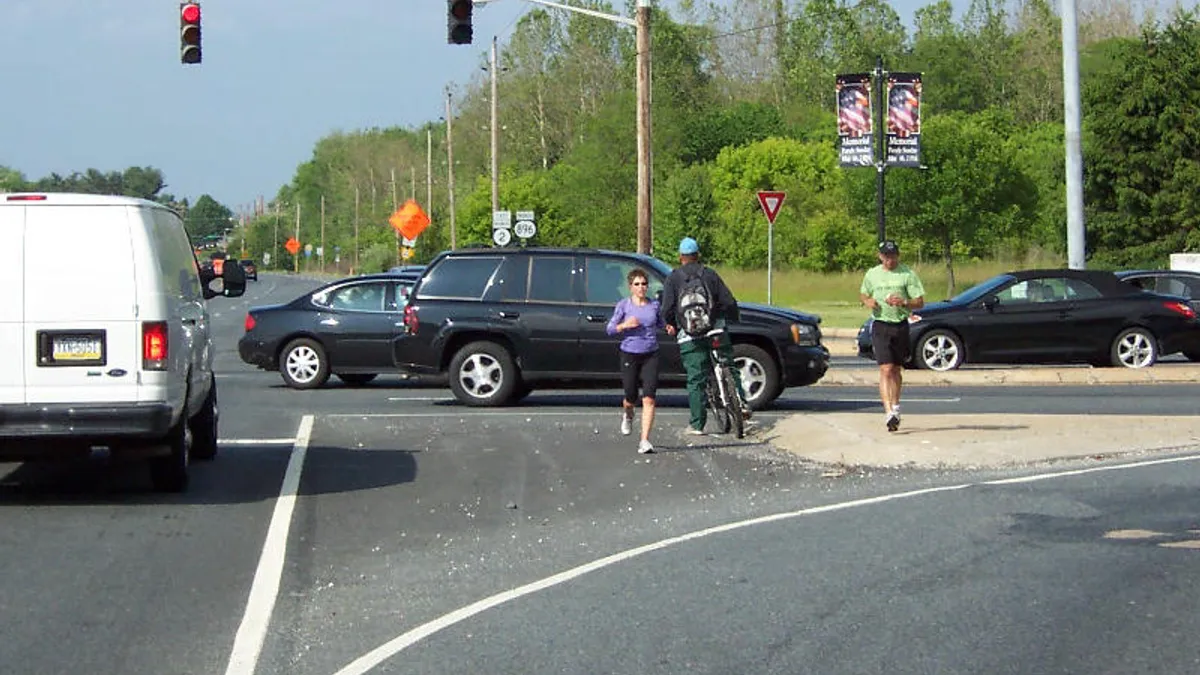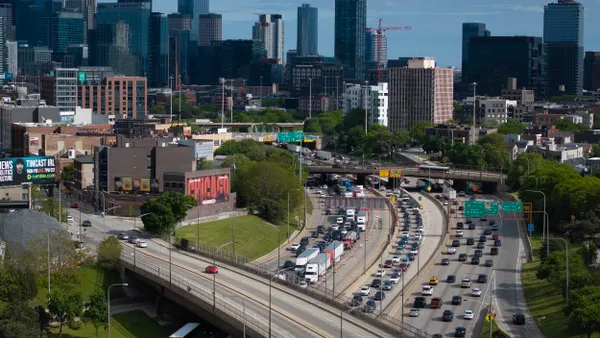UPDATED: May 21, 2021: Pedestrian deaths had their highest year-on-year jump in 2020, according to new figures the Governors Highway Safety Association (GHSA) released Wednesday.
The GHSA projects that there were 6,721 pedestrian deaths in the whole of 2020, a 4.8% increase from the 6,412 fatalities reported in 2019. Given there was a 13.2% decrease in vehicle miles traveled (VMT) in 2020, the pedestrian fatality rate was 2.3 per billion VMT, which GHSA said is a "shocking and unprecedented" 21% increase from 1.9 in 2019.
GHSA blamed a variety of factors for the increase, including more reckless driving as roads were less congested during the coronavirus pandemic, as well as drunk, drugged and distracted driving, combined with infrastructure that prioritizes cars over walking and bicycling.
Dive Brief:
- Pedestrian deaths in the United States are on track for a record high in 2020, according to a projection from the Governors Highway Safety Association (GHSA), even as driving dropped due to the coronavirus pandemic.
- GHSA projected the pedestrian fatality rate jumped 20% during the first six months of 2020, with 2,957 pedestrians killed in motor vehicle crashes January through June last year. That is six more than the same period in 2019. The increase in fatalities also comes as vehicle miles traveled (VMT) fell 16.5% nationwide in that period, with the rate of drivers striking and killing pedestrians jumping to 2.2 deaths per 1 billion VMT, up from 1.8 deaths per 1 billion VMT in 2019.
- Pedestrian deaths are historically higher in the second half of the year due to more outdoor activity in the summer months and students being out of school. The holiday period also means more people are out celebrating — even during a pandemic. GHSA warned this projection could indicate the largest ever annual increase in the U.S. pedestrian fatality rate per mile driven. Figures for the second half of the year are expected in the coming months, once state-level data has been tabulated and analyzed.
Dive Insight:
The GHSA has been one of several groups sounding the alarm about the rising rate of pedestrian fatalities in the U.S., basing its findings on data from state highway safety offices in all 50 states and Washington, DC. The National Safety Council (NSC) also found earlier this month that motor vehicle fatalities in 2020 reached their highest point since 2007 in the United States.
Despite the alarming nationwide trend, there are some encouraging signs at the state level — albeit unevenly distributed. GHSA said 20 states and DC saw declines in the number of pedestrians killed by drivers for the first half of 2020 compared to 2019. Richard Retting, general manager and director of safety and research at Sam Schwartz Consulting, who conducted data analysis for GHSA, said the numbers in Delaware and Kentucky are particularly heartening as they have seen declines for three consecutive years.
While there are no definitive answers as to why why Delaware has seen a 17% decline from 2019 to 2020 in fatalities, GHSA highlighted the state’s enforcement during the summer and outreach by the Delaware Rapid Transit along high-crash routes. Meanwhile, Kentucky saw a 29% decrease over the same time period. In terms of percentage increases from the first half of 2019 to the first half of 2020, Kansas led all states at 286%, followed by Rhode Island (233%) and New Hampshire (100%).
"It's almost like the stock market," Retting said. "If you pick a stock because it's done well for three or four days in a row, the fifth day it might go down. And so the past is not a guarantee of the future. But it is good to see some states like Delaware and Kentucky with consecutive years. This is what I like to look for as a trend, not just a reduction for any given year, but a pattern of several years in a row with pedestrian deaths going down."
There are plenty of theories about how pedestrian fatalities can be reduced nationwide, something that has received particular attention during the pandemic with fewer cars on the roads but vehicle speeds increasing as congestion is reduced. Smart Growth America recently released a report in which the nonprofit urged that streets be designed with other transportation modes in mind so drivers might be less inclined to drive fast.
Retting said elected leaders and planners need to use every tool in the toolbox and cannot rely on changing street design to improve safety, including by looking to enforcement through speed camera programs and other initiatives. However, transportation experts have also highlighted the racial disparities in some enforcement due to the dangers of police stops for Black and Latinx drivers, who are often also subject to more stop-and-searches than White drivers.
And as with previous GHSA reports, the majority of fatalities were also found to happen on local roads and at night.
"I believe strongly in street design, but we can't wait decades for streets to get safer, even if we all agree that's the way to go," Retting said. "None of us has a magic wand and trillions of dollars to fix everything tomorrow… [Enforcement] is like a vaccine against speeding behavior. We don't have to wait for roadways to change to slow drivers down and make pedestrians safer."













